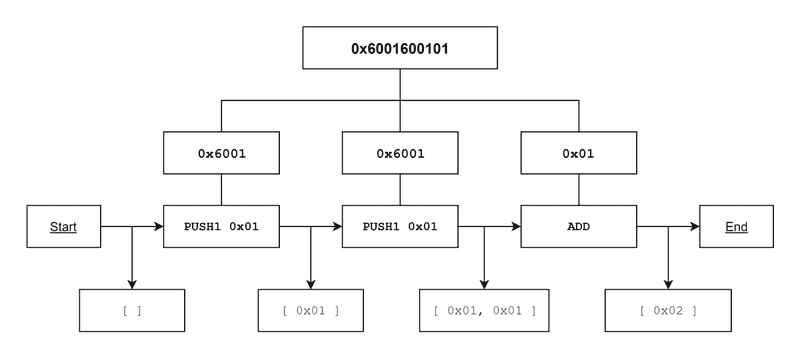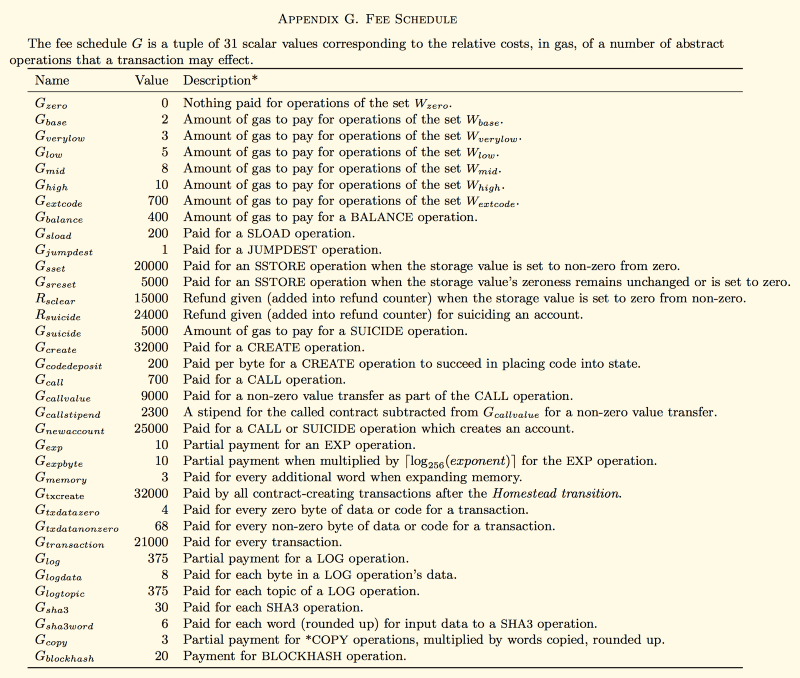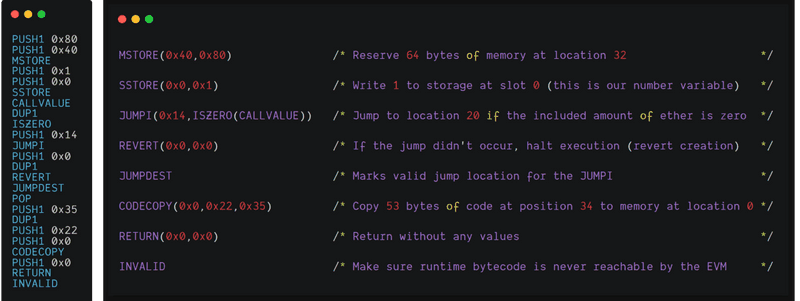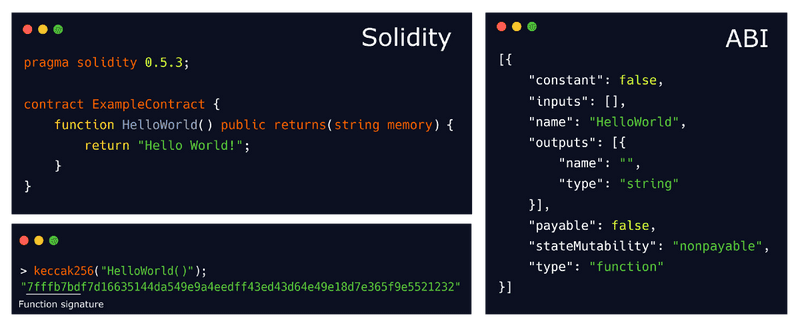Diving into Ethereum’s decentralized ecosystem for building
If you’ve tried developing a smart contract on the Ethereum blockchain, or have been in the space for a while, you might have come across the term “EVM”, short for Ethereum Virtual Machine. Virtual machines are essentially creating a level of abstraction between the executing code and the executing machine. This layer is needed to improve the portability of software, as well as to make sure applications are separated from each other, and separated from their host.
Creating a smart contract
Smart contracts are often written in a programming language called “Solidity”, a language similar to JavaScript and C++. Other languages for writing smart contracts include Vyper and Bamboo. Before Solidity was released, other languages like Serpent (deprecated) and Mutan (deprecated) were used.

Smart contract languages like Solidity cannot be executed by the EVM directly. Instead, they are compiled to low-level machine instructions (called opcodes).
Opcodes
Under the hood, the EVM uses a set of instructions (called opcodes) to execute specific tasks. At the time of writing, there are 140 unique opcodes. Together, these opcodes allow the EVM to be Turing-complete. This means the EVM is able to compute (almost) anything, given enough resources. Because opcodes are 1 byte, there can only be a maximum of 256 (16²) opcodes. For simplicity's sake, we can split all opcodes into the following categories:

Bytecode
In order to efficiently store opcodes, they are encoded to bytecode. Every opcode is allocated a byte (for example; STOP is 0x00). Let’s take a look at the following bytecode: 0x6001600101

During execution, bytecode is split up into its bytes (1 byte equals 2 hexadecimal characters). Bytes in range 0x60–0x7f (PUSH1-PUSH32) are treated differently because they include push data (which needs to be attached to the opcode, instead of being treated as a separate opcode).
The first instruction is 0x60 which translates to PUSH1. Therefore, we know the push data is 1 byte long, and we add the next byte to the stack. The stack now contains 1 item, and we can move to the next instruction. Since we know 0x01 is part of a PUSH instruction, the next instruction we need to execute is another 0x60 (PUSH1) along with the same data. The stack now contains 2 identical items. The final instruction is 0x01, which translates to ADD. This instruction will take 2 items from the stack, and pushes the sum of these items to the stack. The stack now contains one item: 0x02
Contract state
While many popular top-level programming languages allow users to directly pass arguments to functions (function(argument1,argument2)), lower-level programming languages often use a stack to pass values to functions. The EVM uses a 256-bit register stack from which the most recent 16 items can be accessed or manipulated at once. In total, the stack can only hold 1024 items.
Because of these limitations, complicated opcodes instead use contract memory to retrieve or pass data. However, memory is not persistent. When contract execution finishes, the memory contents will not be saved. Thus, while stack can be compared to function arguments, memory can be compared to declaring variables.
In order to store data indefinitely and make it accessible for future contract executions, one can use storage. Contract storage essentially acts as a public database, from which values can be read externally without having to send a transaction to the contract (no fees!). However, writing to storage is very expensive (as much as 6000x) compared to writing to memory.
Costs of interacting with smart contracts
Since all contract executions are run by everyone running an Ethereum node, an attacker could try creating contracts including lots of computationally expensive operations to slow down the network. To prevent such attacks from happening, every opcode has its own base gas cost. Furthermore, several complicated opcodes also charge a dynamic gas cost. For instance, the opcode KECCAK256 (formerly known as SHA3) has a base cost of 30 gas, and a dynamic cost of 6 gas per word (words are 256-bit items). Computationally expensive instructions charge a higher gas fee than simple, straightforward instructions. On top of that, every transaction starts at 21000 gas.

When executing instructions which reduce state size, gas can also be refunded. Setting a storage value to zero from non-zero refunds 15000 gas, while completely removing a contract (using the SELFDESTRUCT opcode) refunds 24000 gas. Refunds only occur after contract execution has completed, thus contracts cannot pay for themselves. Additionally, a refund cannot exceed half the gas used for the current contract call.
If you’re interested in reading more about gas, feel free to take a look at this excellent article: “What is Gas?”
Deploying a smart contract
When deploying a smart contract, a regular transaction is created, without a to address. Additionally, some bytecode is added as input data. This bytecode acts as a constructor, which is needed to write initial variables to storage before copying the runtime bytecode to the contract’s code. During deployment, creation bytecode will only run once, while runtime bytecode will run on every contract call.

We can split up the bytecode shown above into three pieces:
Constructor
60806040526001600055348015601457600080fd5b5060358060226000396000f3fe

Runtime
6080604052600080fdfe

Metadata
a165627a7a723058204e048d6cab20eb0d9f95671510277b55a61a582250e04db7f6587a1bebc134d20029
At the end of this bytecode, a Swarm hash of a metadata file created by Solidity gets appended. Swarm is a distributed storage platform and content distribution service, or, more simply stated: a decentralized file storage. Although the Swarm hash will also be included in the runtime bytecode, it will never be interpreted as opcodes by the EVM, because its location can never be reached. Currently, Solidity utilizes the following format:
0xa1 0x65 'b' 'z' 'z' 'r' '0' 0x58 0x20 [32 bytes swarm hash] 0x00 0x29
Therefore, in this case, we can extract the following Swarm hash:
4e048d6cab20eb0d9f95671510277b55a61a582250e04db7f6587a1bebc134d2
The metadata file contains various information about the contract, such as the compiler version or the contract’s functions. Unfortunately, this is an experimental feature, and not many contracts have publicly uploaded their metadata to the Swarm network.
Decompiling bytecode
Several projects have created tools to attempt making bytecode more readable. For example, you can try decompiling a contract on mainnet using eveem.org or ethervm.io. Unfortunately, some parts of the original contract source, such as functions names or event names, are always lost due to optimization done by the compiler. Nonetheless, most function names can still be brute forced by comparing function signatures to large datasets containing popular function and event names (see 4byte.directory).
Contract calls usually require an “ABI” (Application Binary Interface), which is a piece of data documenting all functions and events, including their needed input and output. When calling a function on a contract, the function signature is determined by hashing the name of the function including its inputs (using keccak256), and truncating everything but the first 4 bytes.

As you can see in the image above, our function HelloWorld() resolves to the signature hash 0x7fffb7bd. If we would like to call this function, our transaction data needs to start with 0x7fffb7bd. Arguments which need to be passed to a function (none in this case) can be added in 32-byte pieces called words after the signature hash in a transaction’s input data.
If an argument contains over 32 bytes (256 bits) of data, like an array or string, the argument is split into multiple words which are added to the input data after all other arguments have been included. Moreover, the total size of all words gets included as another word, before all array words. At the location where the argument would have been included, the start position of the array words (including the size word) is added instead.
Conclusion
Ethereum provides a decentralized ecosystem for developers to build awesome products using Solidity & the EVM. Although interacting with the EVM through smart contracts might be a lot more expensive than running programs on traditional servers, there are lots of use cases in which decentralization is favored over costs.
If reading this article made you interested in learning more about developing smart contracts, dive deeper into how Solidity works by taking a look at “Introduction to Smart Contracts”. Thanks for reading!
References
- Wood, G. (2014). Ethereum: A secure decentralised generalised transaction ledger
- Ethereum Foundation. (2016). Solidity Documentation
- Santander, A., & Arias, L. (2018). Deconstructing a Solidity Contract
- Howard. (2017). Diving Into The Ethereum Virtual Machine